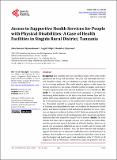| dc.contributor.author | Ndyamukama, Aika | |
| dc.contributor.author | Dillip, Angel | |
| dc.contributor.author | Chipwaza, Beatrice | |
| dc.date.accessioned | 2022-08-30T08:30:53Z | |
| dc.date.available | 2022-08-30T08:30:53Z | |
| dc.date.issued | 2022-03-30 | |
| dc.identifier.uri | https://doi.org/10.4236/health.2022.143028 | |
| dc.identifier.uri | https://dspace.nm-aist.ac.tz/handle/20.500.12479/1533 | |
| dc.description | This research article was published by Scientific Research Publishing Inc, 2022 | en_US |
| dc.description.abstract | Background: It is estimated that above one billion people (15%) of the world’s populations are living with disabilities. The poor and unfriendly infrastructure at health facilities is the core challenge for people with physical disabilities in accessing healthcare. This study aimed to explore at what extent the existing infrastructure and design of health facilities in Singida rural district, Tanzania supports people with physical disabilities to access healthcare. Methods: A cross sectional health facility-based assessment of all thirty-two functioning health facilities in the district was done between June and December 2020 using observational checklist and key informants’ interviews consist of measurement procedures of the architectural condition of health facilities. Observation checklist was designed based on standard of health facilities in Tanzania, national guideline for safe care standards for dispensaries, health centers and district hospital of 2014 and national guideline for water, sanitation and hygiene in healthcare facilities of 2017. Data were analyzed by SPSS-26 using descriptive statistics to obtain frequencies tables, percentage and figure. Qualitative data were analyzed by using NVivo-12 software. Results: The study revealed that there was no signage, entrance area, parking and toilets designated for people with physical disabilities in all health facilities. There was no special seat, examination table/bed and special weight scale for people with physical disabilities in all facilities. Also, the doors were not wide enough to support wheelchair user to maneuver in all health centers and dispensaries. In addition, door handles were not user friendly for wheelchair users. In fact, only the hospital and health centers had wheelchairs while 27 (96.4%) of all dispensaries had no wheelchairs. Furthermore, ramp and pathways were not available in all dispensaries. All health facilities had stairs but the challenge was most of the staircases had no floor located before the steps. Conclusion: The study revealed that the infrastructures in most healthcare facilities pose challenges to people with physical disabilities when they access healthcare services. These findings call for need of improving health facilities’ infrastructure to accommodate people with physical disabilities and this should be given a priority. | en_US |
| dc.language.iso | en | en_US |
| dc.publisher | Scientific Research Publishing Inc. | en_US |
| dc.subject | Healthcare Services | en_US |
| dc.subject | Health Facilities | en_US |
| dc.subject | People with Physical Disabilities | en_US |
| dc.title | Access to Supportive Health Services for People with Physical Disabilities: A Case of Health Facilities in Singida Rural District, Tanzania | en_US |
| dc.type | Article | en_US |

